|

by Marsha Freeman
from
21stCenturyScienceTech
Website
KEPLEROPOLIS, July 20, 2059
Today is a day of joyous celebration on
Mars. As the citizens of Kepleropolis look back 90 years, to
commemorate the historic first steps of human explorers on the Moon,
their eyes are fixed on the imminent launch of their newest
spacecraft, Kepler II.
This will be the first craft to use the
revolutionary new, and still-experimental,
antimatter propulsion
system. If successful, the spacecraft will reach neighboring stars,
comfortably within the lifespan of the scientists who are anxiously
awaiting the discovery of new worlds. There is great excitement that Kepler II will open up the universe to mankind, just as 90 years
ago, Apollo opened up the Solar System.
While Kepler II will not be carrying a human crew, its mission is to
visit Earth-like planets orbiting distant stars, once thought to be
impossible to reach in a human lifetime. Over its five-year mission,
its predecessor, Kepler I, launched into Earth orbit in March 2009,
had identified hundreds of target solar systems to explore.
Johannes Kepler (1571-1630), who determined the laws of our
Solar System, would undoubtedly be pleased that our scientific
instruments will soon be looking for planets around other stars.
While everyone in Kepleropolis is anxiously awaiting today’s Kepler
II launch, pausing to follow the minute-to-minute progress of the
launch preparations on large screens placed throughout the city,
researchers working in the Advanced Propulsion Laboratory are
especially anxious.
The revolutionary new anti-matter propulsion drive that will take
Kepler II to the stars began its development more than 20 years ago
on Earth. But it was brought to realization by a scientific team
working in the Lab in Kepleropolis. Now it was time see if the
system could deliver.
Just as those who came before them nervously watched the first
satellite launch, in 1957; the first manned mission, in 1961; the
first human footsteps on the Moon, in 1969; and the first manned
landing on Mars, in 204 , these young pioneers paced back and forth,
waiting for lift-off.
Finally, the moment arrived, chosen to coincide exactly with Neil
Armstrong’s first step onto the Lunar surface, now almost a century
earlier. The booster engines ignited, and Kepler II was easily
carried aloft. Once in Mars orbit, the anti-matter drive sprang to
life.
Kepler II was on its way to discover new Earths.
Very
few people living on Mars today were alive when Neil Armstrong
spoke those first words from the surface of the Moon. But no one
here can forget on whose shoulders he stands. However, what is very
difficult for citizens of Kepleropolis to understand, especially
those who did not witness or participate in the Second American
Revolution of 2010, is how it was that so many decades could have
been wasted.
For years after the abrupt end of the
Apollo Program in 1972, space
enthusiasts would lament that it would take a crisis, like that
faced by President John F. Kennedy in 1961, to goad an
administration in Washington to make the commitment needed for a
visionary, multi-decade program to move human civilization into
space.
That crisis came in the Fall of 2009.
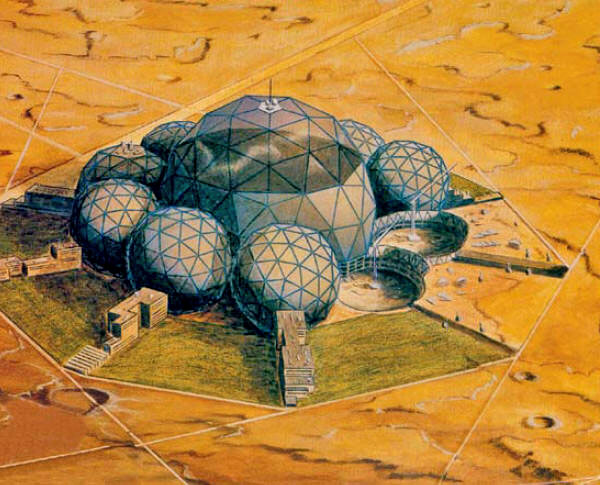
Kepleropolis, the
city on Mars.
The center hub is the
scientific, cultural, and educational focus of the city,
with museums,
universities, laboratories, theaters, and other cultural centers.
In the next ring are
the residential areas; and beyond, industrial and agricultural facilities.
In 2059, there are
nearly a half million residents on Mars.
Perception finally caught up with reality.
The global financial house of cards,
based not on any physical economy, but on criminal enterprise,
speculation, and outright stealing, in order to “make money,”
finally collapsed. Commerce, production, and life itself came to a
standstill. Here was the opportunity to start over, sweep away
decades of pessimism and failed policies, and return to the
principles which today, on Mars, seem like common sense.
The revolution began by “exorcising” the
worship of money.
Starting Over
A series of global, credit-based international exchange-rate and
trade agreements was quickly concluded, reflecting back to the
policies of U.S. President Franklin Roosevelt, and initiated by
economist
Lyndon LaRouche, who had proposed a four-power
agreement among the U.S., Russia, China, and India.
Through this arrangement, each nation
could contribute to the restart of the overall global economy.

Even though
astronauts spent hours per day exercising while in orbit,
they still
experienced musculosketal deconditioning in microgravity.
The effects were not
always fully reversible, once back on Earth.
Here, U.S. astronaut,
Shannon Lucid, is exercising on a treadmill
during her
record-setting 188-day on the Russian Mir space station, in 1996.
One immediate task was turning what
could have been an ugly, violent mob-reaction to the collapse, and
descent into a New Dark Age, into a renewal of the letter and spirit
of the first American Revolution.
Great projects of infrastructure building got underway on Earth, in
the footsteps of the first U.S. Treasury Secretary, Alexander
Hamilton, who had designed and implemented the credit policies that
built the economic infrastructure of a young United States.
The
first task in 2010, was the rebuilding of a planet devastated by
disease, starvation, and war, and to reverse the decades of
accumulated physical decay.
But as space visionaries insisted at that critical moment, only a
multi-generational great project could challenge and mobilize the
long-dormant creative resources of the human mind. The scientific
discoveries of such a project would unleash the next revolutionary
generations of technology, and drive economic growth on Earth.
The politicians reluctantly came to agree. And so, in that spirit,
the project to build a science city on Mars came into focus. The
cultural pessimism that had taken hold in the late 1960s, and kept
its grip on much of the world’s population for 50 years, began to
disappear.
In fact, the natural optimism of humanity had not been extinguished
during the dark decades of economic decline, only submerged. With
the focus now on the future, socially anomic video games, “reality”
television, fixations on sex, violence, and “competitive” sports,
and a “culture” of death had no place. Mankind would, once again,
find its true nature, in the process of discovering the secrets of
the universe.
The question posed to every citizen of
the world was: What can you contribute to the future of mankind?
And so it was decided, in early 2010, by nearly all of the nations
of the world, that through a coordinated effort, enlisting the
necessary talents of all of mankind, within 50 years, human
civilization would move to Mars.
Living on Mars
From the start, moving humanity to Mars had as its central purpose
the ability to acquire a greater understanding of the universe, by
creating a multi-planet home for humanity.
For this reason, scientists explained,
there could be no thought of trying to “save money,” by setting up
an outpost, or an Antarctica-like base-camp on the Red Planet.
A science city was designed, with a
sufficiently large population, which is now approaching half a
million, to support not only the scientific staff and facilities of
Kepleropolis, but, eventually, to create an independent new world,
as the jumping-off point for developing the further reaches of the
Solar System.
Scientists and engineers were optimistic that they could solve the
technical challenges to get man to the outer planets. But medical
professionals were not convinced that men and women could safely
live there. They were unsure of how the human body would adjust to
the one-sixth gravity of the Moon, or, later, the one-third gravity
of Mars.
Would colonists be able to return to the 1-gravity environment of
Earth? they asked. They knew, through previous studies in
microgravity, that after six months in weightless Earth orbit, some
crew members had lost up to 30% of their bone mass.
Even after two
years of recuperative therapy on Earth, some space travelers did not
recover completely.
-
Would the same debilitation face residents
living in the fractional Earth-gravity on the Moon and on Mars?
-
Would they leave Earth, unable to return?
These questions had to be answered,
before more than a few brave souls would volunteer to go.
In order to find answers, research on the Space Station, to
determine the physiological effects of partial-Earth gravity, was,
therefore, greatly accelerated in 2012. Two years earlier, the
European and Japanese space agencies had decided to deploy, as
quickly as possible, a centrifuge to the Station.
The centrifugal
force created through the rotation of the centrifuge would mimic
variable gravity levels, depending upon the rate of rotation.
There had been much hand-wringing years earlier, when NASA cancelled
the Japanese-built centrifuge that had been developed for the Space
Station. Subsequently, a crash program was undertaken, and a small,
yet capable centrifuge was doing partial-gravity tests by 2012.
Medical professionals had observed, through data collected on the
1970s U.S.
Skylab station, the
Russian Mir station in the 1990s, and
the International Space Station (ISS) in the early 21st Century,
that some physiological changes, such as the loss of bone mass,
appeared to be continuous, throughout a stay in micro-gravity, while
other changes reached a plateau.
But would this be the case in the
partial gravity environments of planets?
Centrifuge studies on the Space Station, from 2012 on, indicated
that the one-sixth gravity of the Moon did not reach the threshold
of load on the musculoskeletal system, in particular, to prevent
deterioration.
However, from carefully studying films of the Apollo astronauts
cavorting on the surface of the Moon, medical specialists determined
that when the weight of the 200-pound space suit was added to the
weight of the astronaut, the gravitational load on the skeletal
system could prevent serious bone loss.
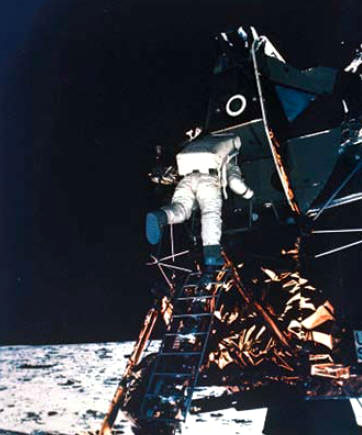
As an Apollo 15
astronaut descends from the Lunar Module
to the surface of the
Moon in the Summer of 1971,
his 200-pound life
support backpack clearly is visible.
Although the added
weight has been found to
counter some of the
effects of the Moon’s only 1/6 Earth’s gravity,
scientists found
there is still a need for some reconditioning,
before return to
Earth.
But for those who were not outside the
spacecraft, some reconditioning was necessary, after long stays on
the Moon, if the Lunar inhabitant wished to return to Earth.
For decades, scientists had worked within their different medical
specialties to find preventive and palliative measures to combat
each one of the body’s adjustments to microgravity. But this
approach left the traveler ingesting a pharmacy-worth of drugs,
sometimes with counteracting effects, and spending many boring hours
on treadmills.
Then, about 20 years ago, it dawned on the engineers who were
developing new exercise equipment, that before returning to Earth,
orbital and Lunar citizens could combat just about all of the
debilitating effects at once, by simply spending time in a
variable-gravity Lunar centrifuge!
Scientists followed their lead.
They reported the results of their
experiments, carried out at the Gauss University Laboratory for
Advancing Human Health on the Moon, to an interplanetary
teleconference of medical specialists in mid-2041.
They had found that over a period of
weeks, by incrementally raising the gravitational load on the body
in a centrifuge, through relatively short doses throughout the day,
immune system reactivity, bone and muscle strength, heart function,
and other physiological systems gradually approached a level
comparable to that on Earth.
Happily, follow-on partial-g studies, in centrifuges on the Space
Station and on the Moon, revealed that, in all but the most
intractable cases, such as bone thinning and calcium loss, the
one-third gravity of Mars was above the threshold for most
physiological changes. As mission planners, back to the 1950s, had
hoped, extended stays on Mars would create no “show-stoppers” for a
return to Earth.
But, as a precaution, still today,
travelers planning a vacation or a business trip to Earth, spend a
couple of weeks in short, periodic sessions in the variable-g
centrifuge, for a 1-gravity “tune up,” under the guidance of the
Kepleropolis medical staff.
Multi-Planet
Families
However, there is one adaptation problem still under intensive study
in the Life Sciences Laboratory in Kepleropolis. It has been
observed that children born and raised on Mars do exhibit
physiological changes (they are taller), but apparently do not
develop the capacity to withstand an Earth-equivalent gravity load.
The skeletal system, which develops on
Earth under weight-bearing gravitational stress during childhood,
has diminished load capacity on Mars. Although some palliative
measures are being tested, none has proved to be satisfactory.
So, for now, multi-planet family
reunions take place on gravitationally “neutral” ground, such as in
Lunar or Mars orbit.
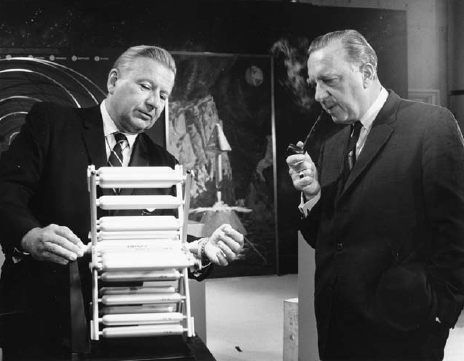
Space visionary
Krafft Ehricke proposed that the disabling effects of adaptation to
microgravity
could be therapeutic for people on Earth.
In this photo, taken
in the CBS-TV studio in September 1966,
he is explaining to
journalist
Walter Cronkite how an orbital hospital could be
designed.
All of these experimental results have,
of course, been shared with colleagues on Earth.
In late 2018, after new laboratory
modules, more advanced equipment, nuclear power supplies, and six
additional crew members had been added to the ISS, a proposal that
had been made in the 1960s by space visionary
Krafft Ehricke,
came to fruition.
It had occurred to Ehricke that the adaptation to microgravity which
was detrimental to the health of Earth-returning crew members, could
be therapeutic to whole groups of people, for whom Earth’s 1-gravity
was a burden.

Japanese Aerospace
and Exploration Agency
This Japanese
centrifuge design was planned for the International Space Station.
The habitats are
small modules designed to hold seeds, plants, microbes, or small
animals.
Depending upon the
speed of rotation of the centrifuge,
partial gravity at
the level found on the Moon and Mars can be simulated.
This included those suffering from
circulatory ailments, where the removal of gravity could lessen the
workload for the heart.
Spinal extension, or a stretching out, seen in micro-gravity (crew
members tend to “grow” an inch or two in space), when
gravity-induced compression is removed, could relieve the pain of
pinched nerves, and chronic bone conditions, Ehricke reasoned. And
so, the Earth-orbital Michael DeBakey Memorial Hospital was
built, with a complete physical therapy wing, along with a
dispensary and clinic to treat on-orbit sickness and injuries from
accidents.
Similar facilities were replicated in Lunar orbit.
Life in microgravity meant that many of the physical infirmities of
old age were no more. The Earth-orbital population grew by leaps and
bounds, as seniors moved out of nursing homes on Earth (which, in
any case, had become more like hospices, where people were sent to
die), and took up residence where they could live comfortably and
work productively, while looking down at their home planet, from 250
miles up.
But there was one very serious and potentially life-threatening
biological hazard in space that was not so easily resolved: exposure
to radiation.
In low-Earth orbit, the
Van Allen belts deflect harmful radiation,
protecting crews. And on planetary bodies, there is no lack of
material to shield people, plants, and animals from the constant
bombardment of cosmic rays and solar particles and radiation. The
first extraterrestrial living quarters were simply covered with
Lunar and Martian soil.
More recently, new materials have been
developed to blanket the cities, which can filter out damaging rays,
while letting in natural light.
But what about the radiation that crew members would be exposed to
during the trip to Mars, navigating through up to 50 million miles
of radiation-soaked interplanetary space? Medical professionals had
fretted over this danger for decades. Technologists had spent long,
tedious hours in laboratories, trying to figure out how to put
radiation shielding around a spaceship to protect the crew.
The solution, however, was much simpler:
avoid exposing the travelers to
dangerous doses of cosmic radiation, by getting to Mars as
quickly as possible.
Getting to Mars
Today, families of vehicles navigate the ocean of interplanetary
space around the clock, traveling between the Earth, the Moon, and
Mars.
Only a few miles from downtown Kepleropolis is the
Interplanetary Space Launch Center. The space port is responsible
for coordinating the vehicles arriving and departing the Red Planet,
similar to the function of a busy airport on the Earth.
Once a month, for example, a spacecraft arrives from the vicinity of
the Earth or the Moon, delivering astronomers who will carry out
studies of the universe from the unique vantage point provided by
the Mars-orbital radio and optical telescopes. There are frequent
exchanges of scientists, who study the anomalies among the
astronomical observations made from different vantage points, near
the Earth, the Moon, and Mars.
Of course, there are also business
trips, and recreational and family visits.
What made this routine personal contact between the planets
possible? It was changing the relative relationship between space
and time. Conventional rockets bring people to Earth-orbit in eight
minutes, and to the Moon in two days.
Extend that technology to
Mars, and the trip could take seven or more months.
But 'today,' to traverse the tens of
millions of miles to Mars,
takes the same time as it does to go to
the Moon!
(above video)
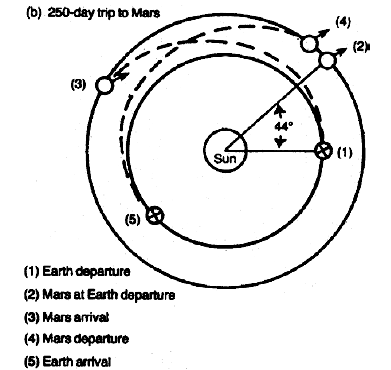
In 1925,
Walter Hohmann designed the minimum energy transfer orbits show here.
The crew starts out
when Earth (1) is 44° ahead of Mars (2), and intersects Mars in its
orbit (3),
having traveled about
250 days.
After spending more
than a year on Mars, the craft leaves Mars orbit (4)
and arrives back on
Earth, another 250 days later, at point (5).
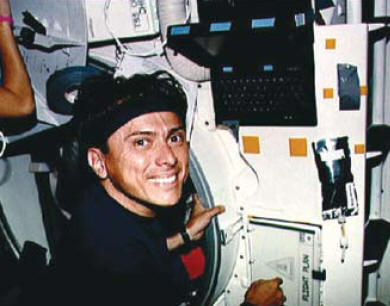
Astronaut and plasma
physicist
Franklin Chang-Diaz
is seen here during
flight STS-46, aboard orbiter Atlantis, in August 1992.
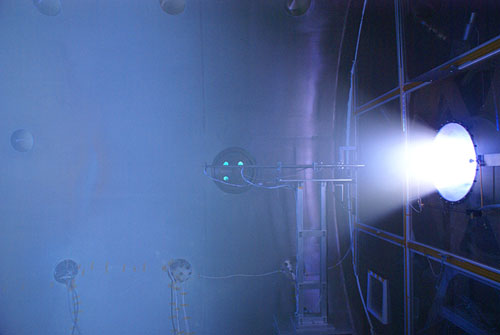
This image is from a
video (below video) of a laboratory test in July 2009,
of the first
stage of the VASIMR plasma rocket.
That stage heats a
gas to over 10,000°, creating a plasma.
Chang-Diaz plans to
test a small VASIMR engine on the Space Station in the next few
years.
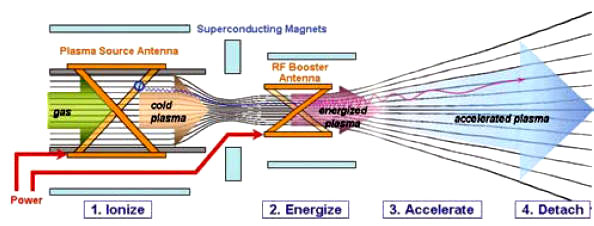
The VASIMR rocket is made up of three principal stages:
1. a gas is ionized;
2. the plasma is
energized and accelerated;
and 3. the plasma is
detached from the rocket by a magnetic nozzle.
The nozzle directs
the exhaust, to produce thrust.
The development of a fusion-powered plasma rocket has reduced the
travel time between Earth and Mars to less than a week. No longer
would doctors have to worry about subjecting crews to weeks, or
months, of damaging radiation, or the debilitating effects of
weightlessness.
The creation of the fusion rocket can be largely credited to the
talent and perseverance of Dr.
Franklin Chang-Diaz.
A former astronaut and plasma physicist,
Chang-Diaz was convinced, from the time he was a researcher at MIT
in 1979, that the only way to go to Mars was to go beyond the
chemical rocket propulsion technology that had been used for 50
years. Mars travel required something in an entirely new physical
regime - a plasma rocket that could one day be powered by
fusion energy.
Chang-Diaz established the Advanced Space Propulsion Laboratory at
the Johnson Space Center in Houston, in 1993, and started on what
became a multi-decade quest to develop the technology mankind would
need to go to the planets.
Scientists pooh-poohed the project.
“Everyone knows fusion power is
impossible,” some muttered. “And even if it weren’t, you will
never design a rocket that can use it.”
The team that Franklin Chang-Diaz
assembled, including his younger brother in Costa Rica, spent 30
years finding a solution to the challenge of designing a system that
could withstand the temperature, in the millions of degrees, of a
fusion plasma, and transform it into propulsive thrust for a rocket.
Why Fusion?
When it comes to rocket propulsion, the hotter, the better.
The
efficiency of the rocket engine increases, as the temperature and
velocity of the propellant pushed out the rear increases. And the
energy produced by the fusing of light ions is orders of magnitude
higher than that of any other energy source that has so far been
developed.
For comparison, the temperature of the propellant expelled by the 1980s Space Shuttle’s main engine, from the chemical combustion of
hydrogen and oxygen, was about 14,000° Centigrade. At that
temperature, the exhaust velocity is about 4,500 meters per second.
The fusion-powered plasma, in the millions of degrees, is about 60
times more efficient, as the plasma particles can move at velocities
of 300,000 meters per second.
Chang-Diaz designed
the VASIMR, for Variable Specific Impulse Magnetoplasma Rocket. The concept was based on the use of a plasma,
or high-temperature electrically charged gas, instead of the burning
of chemical fuels. The first-generation engine consisted of three
cells, or stages.
In the first stage, a gas, such as hydrogen, is turned into a
plasma, by heating it to more than 10,000°. At that point, the
electrons are stripped away from the atoms.
In the second stage, the plasma gas is heated to the desired
temperature, using electromagnetic radio waves. The third stage -
the most challenging - is to coax the plasma out of the rocket
engine, to create a plasma exhaust, and rocket thrust. To do this, VASIMR takes advantage of the fact that the electrically conducting
plasma can be directed by magnetic fields.
A unique magnetic nozzle was developed,
to direct the flow of the hot plasma out of the engine, without
touching the sides of the nozzle.
What makes this engine “variable”?
The amount of thrust produced can be
changed by varying the amount, and weight, of the gas that is being
expelled, as well as the strength of the magnetic field which
directs the plasma. At the start of an interplanetary trip, more, or
heavier propellant will be used, to give the spaceship the thrust it
needs to start on its journey, and pick up speed.
Once the appropriate speed is reached, the engine can be “throttled
back” to lower thrust levels. This is done by reducing the mass of
the plasma exhaust, while increasing the velocity of the exhaust
particles. The higher exhaust velocity is the most fuel-efficient
operating mode. By “tuning” the fusion-powered ship, its
acceleration is variable.
This capability turned out to be critical, when, six years ago, a
ship that suffered a serious mechanical breakdown mid-way to Mars,
had to abort the mission and quickly return to Earth.
As the crew approaches the half-way mark, the spacecraft will start
its deceleration, so it can approach the orbit of Mars, and dock
with one of the Mars-orbital space stations. From there, small
shuttle vehicles easily transport the passengers to the surface of
the planet.
VASIMR was the first engine designed to be able to efficiently move
either people or freight. For the human trips to Mars, clearly, time
was of the essence, so, for human transport, the VASIMR engine was
energized with fusion power, and operated to optimize speed.
But to build Kepleropolis, thousands of tons of equipment,
life-support systems, and structural materials taken largely from
the Moon, but also from Earth, had to be transported to Mars. In
this case, it was not speed, but cargo-capacity that was optimized.
Dr. Chang-Diaz began his laboratory ground testing years before
fusion energy was available. The first stage of the experimental
rocket engine, and of the second-stage radio frequency plasma
heating, were
successfully tested during the
Summer of 2009.
In 2012, a first flight version of the
VASIMR was ready to be tested in space, on the Space Station. The
test engine used the Station’s electrical supply for the kilowatts
of power needed to heat the plasma. The small thrust produced was
even used to boost the Station into a slightly higher orbit.
Parallel to the development of the plasma rocket technology, there
was a crash effort to develop a multimegawatt space nuclear fission
plant. This technology had shown great promise decades earlier, but
had been abandoned in the early 1970s, in the United States, when
there was no plan to go to Mars, and in the early 1990s in Russia,
after the collapse of the Soviet Union.
In 2030, a revolutionary 200 MW nuclear-powered VASIMR rocket got
its first test run in Earth orbit.
The nuclear energy source used
was an improved version of the
Russian Topaz reactor from the 1990s.
Just four years later, nuclear-propelled cargo ships were making
regular runs between the orbits of the Earth and the Moon. Not long
after that, ships were delivering cargo from the Moon’s orbit, to
that of Mars - in only 39 days.
Interplanetary commerce had become a
reality.
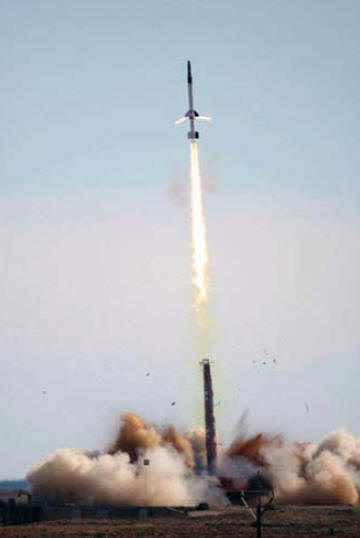
The Australian
University of Queensland Hypersonics Initiative
has produced
impressive results testing engines
that reach speeds of
more than five times the speed of sound.
This June 2007 Hy-CAUSE
test was a collaborative effort,
with the U.S.
Department of Defense.
A Worldwide Effort
Dr. Chang-Diaz’s VASIMR plasma rocket was, by no means, the only
fusion design tested, nor is it the only one flying today. A
broad-scale research and development program was restarted in 2010,
to apply fusion to power space travel. A major contribution to the
international fusion effort came from the stunning results China and
South Korea had already achieved.
Every nation was called upon to contribute to space transportation
infrastructure. For instance, Australia, where a band of young
university enthusiasts had taken the lead, in the early 21st
Century, in hypersonic engine testing, developed a family of
trans-atmospheric vehicles, that could efficiently carry passengers
in a scram-jet-powered airplane-like vehicle, from the surface of
the Earth, to low-Earth orbit.
This development also brought to
fruition a dream that went back as far as the space program itself -
the ability to travel between the farthest points on Earth in a
couple of hours, rather than the better part of a day.
Brazil, fortunate enough to be located at the Equator (the closer to
the Equator, the less energy needed to launch into orbit),
inaugurated its Alcantara launch facility in 2011, and is now a
major interplanetary space port, especially servicing vehicles
produced by nations in the Southern Hemisphere.
Japan and Europe took up the task, along with Russia, of building
unmanned spacecraft to bring cargo to the variety of Earth-orbiting
space stations, satellites, Lunar space vehicle assembly, repair and
check-out garages, and other infrastructure. These nations, plus
China and India, by 2017, had also deployed fleets of manned
vehicles, to shuttle crew members from Earth to orbit.
While chemical-fueled vehicles still have their place - in lifting
large payloads into low-Earth orbit - from there, and through
interplanetary space, fission and fusion power are the baseline
transport systems today.
It goes without saying that meeting the challenges of developing
nuclear and fusion systems that could be flown in space, made
revolutionary new energy technologies available on Earth. In 2010,
when the world’s dying economy started to come back to life, an
immediate crisis to be faced, was the lack of adequate supplies of
power. It seems beyond belief today, but then, nearly one-third of
the Earth’s people did not even have access to electricity.
Faced with the reality of this crisis, virtually overnight, the
silly notions that diffuse solar energy, or that burning the Earth’s
food supply (i.e., “biofuels”) could remedy the world’s energy
crisis, were pushed aside.
Energy flux density, the amount of power
that flows past a given surface in a fixed amount of time - which
the American economist LaRouche had developed as the measure of
efficient power back in the 1970s - was the only criterion
applied to choosing power sources.
Since the 2020s, energy has not been a constraint on Earth.
Abundant nuclear power transformed not
only the standard of living of all Earth’s inhabitants, it created
new supplies of the freshwater that nourishes life itself, an array
of new medical applications, energy to power the all-electric
transportation systems that have replaced the primitive and wasteful
use of finite supplies of fossil fuels, and enabled the industrial
development of the Moon.
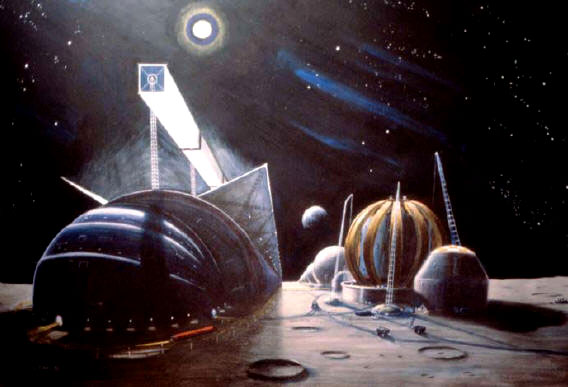
Selenopolis, Krafft
Ehricke’s
city on the Moon, seen here in an artist’s depiction,
is the first triumph
of human creativity and imagination in the colonization of space.
The city, housing
thousands, is powered by fusion reactors, seen under construction on
the right.
Although Selenopolis
is covered with lunar soil, to provide shielding against radiation,
a series of mirrors brings natural sunlight in to the city.
A monorail system,
seen on the outer rim of the city, connects it to mining and
manufacturing sites on other parts of the Moon.
Ehricke proposed a
detailed series of technologies to be used for the industrial
development of the Moon.
In this diagram of
lunar materials processing, three techniques are illustrated for the
underground mining and extraction of lunar materials,
using small nuclear
detonations.
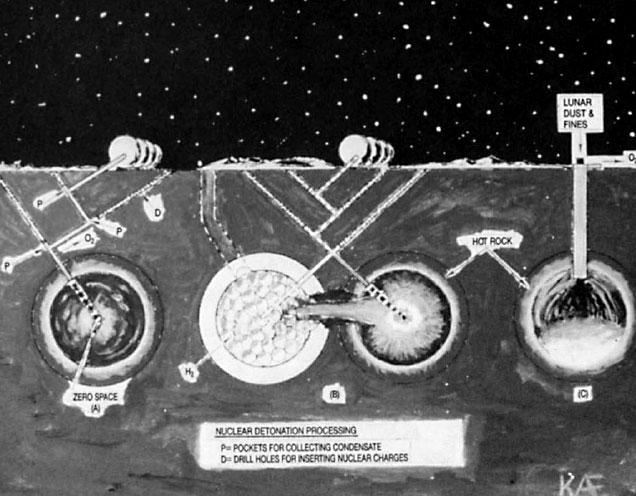
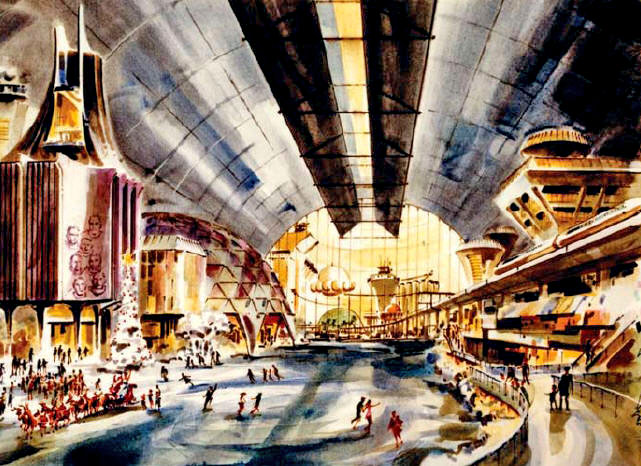
Courtesy of Krafft Ehricke
Winter in Selenopolis:
While some residents
of the city on the Moon enjoy ice skating and other Winter sports,
others visit the Hall
of Astronauts Museum, on the left.
The city replicates
various climates and seasons on Earth,
making the
Selenarians feel right at home.
Krafft Ehricke’s
Plans Revived
None of what has been accomplished on Mars over these past 50 years,
would have been possible if not for the pioneers who took on the
challenge of
living on the Moon. For all of the discussion and
disagreements 50 years ago, as to whether it were necessary to live
on the Moon before going to Mars, no one today questions the wisdom
of the decision to take that route.
In fact, the conditions on the Moon are more severe, and
un-Earth-like, than on Mars. By tackling the Moon first, later, when
it became possible to safely go to Mars, the technologies that were
needed to live there, had already been largely developed and tested
- some had failed and been improved - and were proven. The Lunar
test-bed did not just make Mars colonization easier; it made it
possible.
At the start of the global Mars colonization program, in 2010, no
one had ever lived on the Moon for more than a few days, and even
that had been 40 years earlier, during the
Apollo Program.
Those first Lunar explorers had carried
with them everything they needed. They were limited by that era’s
rocket technology to exploring only the near-equatorial regions of
the Moon, and the near side of the Moon, which always faces the
Earth. To live on the Moon for months, if not years, required an
entirely new approach.
For guidance, and in order to avoid wasting any more time than had
already been frittered way, the exquisitely detailed Lunar
industrialization plans of the visionary Krafft Ehricke were
picked from the bookshelves and dusted off.
Highly energy-dense nuclear technologies, Ehricke explained, would
hold the key to living in a place without an atmosphere, virtually
without water, with a two-week night, with intense radiation, and
wide temperature extremes. On Earth, a productive standard of living
in 2010 required a per capita consumption of tens of kilowatts of
electrical energy. On the Moon, megawatts per capita were required.
For Mars, considering also the transport requirements, electricity
consumption today is approaching the terawatt (1 trillion watts)
range.
In the early 2020s, multi-megawatt nuclear fission reactors were
robotically placed on the surface to provide the power for the first
tens of arriving Lunar settlers. A decade later, multi-gigawatt
nuclear power stations gave life to the beginnings of a Lunar city.
As the first Lunar settlement grew, industrial manufacturing
followed.
Underground caverns, charged with nuclear, and later,
fusion explosives, separated and concentrated Lunar raw materials.
Manufacturing plants outfitted with laser, electron-beam, and other
directed-energy power sources shaped the structural materials into
usable form. Construction sites were established to build the grand
city of Selenopolis.
As Lunar industrial processing expanded, less and less semi-and
finished product needed to be imported from Earth. In fact, by 2037,
the flow of commerce had reversed direction.
Before Selenopolis could reach its full economic potential,
fusion power was required. And the Moon itself would be key. The
most efficient fuel for fusion energy - on Earth, the Moon, Mars, or
in rockets - is the fusing of the deuterium isotope of hydrogen, and
the
helium-3 isotope. On Earth, little helium-3 remains, from
deposits by the solar wind. But on the airless, weatherless Moon,
there is a treasure trove of this rare and precious material, on and
near the surface.
Intensive orbital studies of Lunar minerals over the 2010s,
indicated regions of relatively higher helium-3 concentration.
Immediately, the two nations of the world with the most extensive
experience in mining in extremely cold climates - Canada and Russia
- began a joint R&D program to develop the tools that would be
effective in mining helium-3 on the Moon.
As progress on developing Dr. Chang-Diaz’s plasma rocket for Mars
continued, nuclear-powered freighters began making deliveries of
Lunar helium-3 to fuel the fusion reactors on Earth.
Later, that fuel would be needed for the
fusion rockets. In fact, it turned out that the Moon, with its near
total vacuum, was an ideal place for plasma-rocket engine testing,
since the environment was a good analogue for what ships would
encounter in interplanetary space. Happily, Dr. Chang-Diaz was still
nimble enough, at the age of 79, to make the Lunar excursion in
2029, and supervise these decisive tests.
The crowning accomplishment of the Lunar program, was the
establishment of Selenopolis. This first extraterrestrial home for
mankind was actually not all that strange and unfamiliar to the
immigrants from Earth. The city was divided into different regions,
mirroring the variety of climates on Earth, with urban, rural,
agricultural, industrial, and resort areas.
There are museums, Gauss University, and
the Jules Verne Theater, where in stunning clarity, Selenarians
gather to watch the unfolding of human civilization on Mars.
On the Moon, mankind learned how to “live off the land,” processing
Lunar soil to extract oxygen, minerals, and materials, capturing
water ice at the poles, and developing new resources that became the
fulfillment of Krafft Ehricke’s “Extraterrestrial Imperative.”
Mankind had established a multi-planet home. His world had become
“three dimensional.”
Here, the work of three generations had created
the future, for so many more.
The Next 50
Years
Where do we go from here?
Over the next 50 years, the focus of
activity on Mars will change. Now that Kepleropolis is operational,
and the construction phase is drawing to a close, it is the
investigation of life which will become the major focus of
scientific inquiry.
For centuries, scientists speculated about whether there ever was,
or if there is, even today, life on Mars. Throughout the 2010s,
increasingly more sophisticated robotic explorers were sent to try
to find out. The results were all ambiguous.
Finally, the most challenging unmanned mission - an
international sample return - was launched in 2024, and a few
precious pounds of Martian soil and rocks came back to laboratories
on Earth.
Still, no definitive answer.
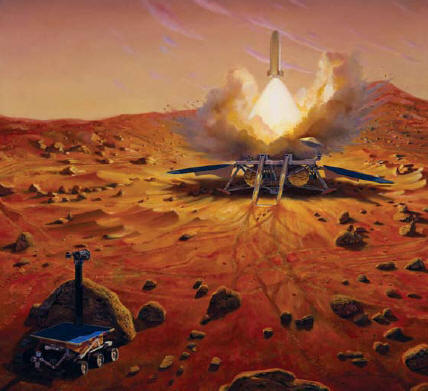
JPL/NASA
Before men are sent
to Mars, in 2024,
an international
robotic mission will be deployed to return samples of rock and soil
to be intensively
examined in laboratories on Earth.
In this artist’s
representation,
an ascent vehicle is
taking off from the Martian surface, to deliver its previous cargo.
The rover, which
collected the samples and delivered them to the vehicle, takes
shelter behind a rock.
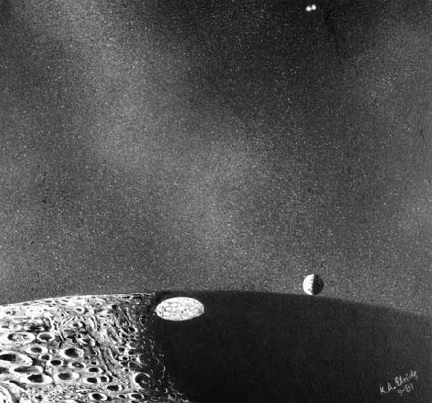
Courtesy of Krafft
Ehricke
One of the
technologies that is now being tested for
terraforming Mars was
first tested in the orbit of the Moon.
In this painting,
each of one of Krafft Ehricke’s Lunettas is providing the equivalent
to a full Moon,
lighting the
perpetually dark lunar pole.
Larger orbiting
mirrors can be used to raise the temperature of Mars.
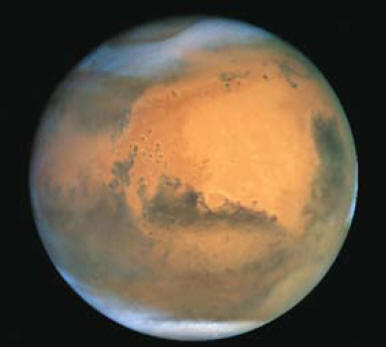
NASA/Hubble Heritage
Team
On June 26, 2001, the
Hubble Space Telescope took this stunning photograph of Mars.
The most Earth-like
planet, Mars has carbon and water ice at the poles,
water and carbon
dioxide frozen in the soil, and indications it is still an active
planet.
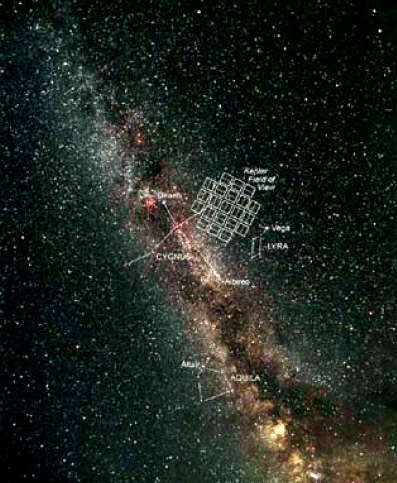
Carter Roberts, Eastbay Astronomical Society/NASA
The mission of Kepler
I, launched in 2009, is to identify Earth-sized planets around other
stars.
This image shows the
region of the Milky Way where the Kepler spacecraft is pointed.
Each rectangle
indicates a specific region of the sky covered by each Charged
Couple Device element of the photometer.
With great agility, and the creativity
that only man could bring to the task, finally, three years after
the first Mars landing, scientists in the field made the stunning
discovery of fossil remains of microorganisms that, at one time,
lived on Mars.
The operative question now under intensive investigation, is whether
there are niches that have somehow been protected from the cold, dry
environment of today’s Mars, where life may still exist.
Scientists have taken their cue from the extensive research on
Earth, of life in extreme environments. They were shocked to find,
in the last decade of the 20th Century, that life is, indeed, found
in extreme temperatures, in high-radiation environments, and even in
places where there is no light. On Mars, this work is being carried
out with the necessary extreme care.
If scientists do find living organisms, one major question to
examine, is whether that life originally came from Earth; or,
whether life on Earth had migrated through interplanetary space, and
originally came from Mars; or if life developed independently, on
both planets. Today there are passionate adherents to each theory.
Whether or not it is found that life still exists on Mars, to make
this planet truly a home for mankind, a process has been started
that will create a “second Earth.”
Terraforming the Red Planet, as far as
can be seen today, will be the work of centuries.
One is reminded of a story in the history books, that when Charles
de Gaulle told a junior officer of a particular kind of tree he
wanted to be planted outside his office, the officer objected,
stating:
“But General, that is a very slow-growing tree. It will
take decades before it produces any shade.” The General replied,
“Then you had best get started right away!”
Those living on Mars
today will not be there to see it turned into a garden, but their
great-great-great-grandchildren will be.
In the late 1920s, Hermann Oberth, the father of space
flight, said that the purpose of space exploration was to “make all
worlds habitable.” That is the goal of the Second Earth project - to
create a biosphere on Mars.
Over the years, scientists have put forward numerous approaches to
terra-forming Mars. But because this is an experiment that cannot, in
any satisfactory way, be carried out anywhere else, but on Mars
itself, it was decided that a number of approaches would be tried at
the same time.
The first order of business, is to raise the temperature on the Red
Planet, to liberate frozen water-ice, at the poles and in the
permafrost, and gasify the frozen carbon dioxide, to thicken the
atmosphere. This will begin a self-reinforcing “runaway” greenhouse
effect (once so foolishly feared on Earth).
One of the pathfinder technologies, used in Lunar orbit over the
past 20 years, is a set of reflective mirrors. These Solettas, or
artificial suns, designed by Ehricke in the 1970s, from an original
idea of Oberth, are directing light reflected from the Sun to
illuminate perpetually shadowed, water-ice-rich polar regions of the
Moon.
On Mars, engineers have determined that the first step, now
underway, needed to transfer this technology, is the deployment of a
modest-sized orbiting mirror, able to raise the temperature in a
given area, by a few degrees. Eventually, once Solettas reach the
terawatt level of power, this warming would activate the hydrosphere
on Mars, liberating some of the frozen water. The size of the
mirror, at a radius of 125 kilometers, required that it be
manufactured entirely out of Martian material.
A second experimental approach now underway, is the “seeding” of the
Martian atmosphere with halocarbons.
These greenhouse gases will slowly raise
the global atmospheric temperature and pressure on Mars, one day
liberating explorers from the bulky spacesuits now donned for field
work, requiring only scuba-type breathing gear. Once
genetically-engineered plants can start living in the carbon-rich
atmosphere, they will oxygenate the air, eventually making Mars
habitable, without the need for special equipment.
We now know there was life on Mars before man arrived. How many
other bodies in our Solar System were, or still are, abodes of life?
This will be intensively studied, to the far reaches of the outer
plants, over the next 50 years.
And starting today, the Kepler II spacecraft is on its way beyond
our neighborhood of planets, to search for life on planets orbiting
other stars.
Throughout human history there have always been naysayers and
pessimists.
The establishment of the city on Mars is
just the most recent proof, that the human spirit can overcome any
crisis:
that by marshalling his unique
creative abilities, man discovers the laws of the universe, and
then shapes the universe to the betterment of all mankind.
|

















